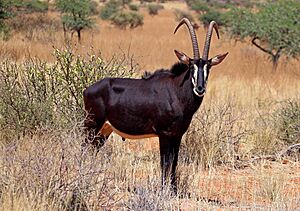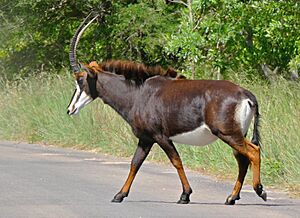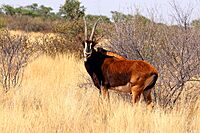Sable antelope facts for kids
Quick facts for kids Sable antelope |
|
|---|---|
 |
|
| An adult male sable antelope in Tswalu Kalahari Reserve, South Africa | |
 |
|
| An adult female crossing the road in Kruger National Park, South Africa | |
| Conservation status | |
| Scientific classification | |
 |
|
| geographic range |
The sable antelope (Hippotragus niger) is a big type of antelope. It lives in wooded savanna areas in East and Southern Africa. You can find them from southern Kenya all the way to South Africa. There is also a separate group living in Angola.
Contents
About Sable Antelopes: Classification
The sable antelope belongs to a group of animals called the Hippotragus genus. This group also includes the roan antelope (H. equinus). Sadly, the bluebuck (H. leucophaeus) was also part of this group, but it is now extinct. All these animals are part of the family called Bovidae, which includes cows, goats, and sheep.
Scientists studied the mitochondrial DNA of a bluebuck in 1996. They found that the bluebuck is a bit different from the roan and sable antelopes. The chart below shows how the sable antelope is related to its family members:
|
|||||||||||||||||||||||||
Different Types of Sable Antelopes
There are four main types, or subspecies, of the sable antelope:
- The southern sable antelope (H. n. niger) is also known as the common or black sable antelope. It was the first type described in 1838. This subspecies often has the darkest fur. It lives south of the Zambezi River, especially in northern Botswana and Zimbabwe. You can also find them in South Africa. Many farmers in South Africa have mixed this type with Zambian sable antelopes. This was done to try and get closer to the nearly extinct giant sable antelope. Today, only about 15% of pure southern sable antelopes are thought to exist in South Africa. Their numbers in Zimbabwe have also dropped a lot.
- The giant sable antelope (H. n. variani) is also called the royal sable antelope. It is named "giant" because both males and females are larger. Their horns are also noticeably longer. This type is found only in a few places in central Angola. It is listed as Critically Endangered, meaning it is at very high risk of disappearing forever.
- The Zambian sable antelope (H. n. kirkii) is also known as the West Zambian or West Tanzanian sable antelope. This type lives in central Angola, western Zambia, and Malawi. It has the largest area where it lives, stretching north of the Zambezi River into parts of the Democratic Republic of the Congo and southwestern Tanzania. It is listed as Vulnerable, meaning it faces a high risk of extinction.
- The eastern sable antelope (H. n. roosevelti) is the smallest of the four types. It lives near the coast in southern Kenya, especially in the Shimba Hills National Reserve. It also ranges through eastern Tanzania and into northern Mozambique.
Sometimes, people use other names for the sable antelope, like "great sable antelope" or just "sable." In Swahili, it's called mbarapi. There are also many local names in different African languages, such as swartwitpens in Afrikaans and ngwarati in Shona.
Physical Description of Sable Antelopes
Sable antelopes show differences between males and females. Males are heavier and about one-fifth taller than females. Their body length is usually between 190 and 255 centimeters (75 to 100 inches). Males stand about 117 to 140 cm (46 to 55 in) tall at the shoulder. Females are a bit shorter. Males typically weigh around 235 kilograms (518 pounds), and females weigh about 220 kg (485 lb). Their tail is 40 to 75 cm (16 to 30 in) long, with a tuft of hair at the end.
Sable antelopes have a strong and sturdy body. They have a thick neck and tough skin. They also have a well-developed mane on their neck that often stands upright. There's a shorter mane on their throat too. Their fur color can range from a rich chestnut brown to black. Females and young antelopes are usually chestnut to dark brown. Males start to get darker and turn black after they are three years old. However, in some southern areas, even females can have brown to black coats. Young calves, less than two months old, are light tan with faint markings. Their belly, cheeks, and chin are white, which stands out against their dark back and sides. They also have long, white hairs below their eyes and a wide, black stripe over their nose.
Both male and female sable antelopes have ringed horns that curve backward. In females, these horns can be 61 to 102 cm (24 to 40 in) long. In males, they are even longer, reaching 81 to 165 cm (32 to 65 in). Sable antelopes usually live for about 19 years in the wild. In zoos or other protected places, they can live up to 22 years.
-
A display of sable antelopes at the Milwaukee Public Museum
Sable Antelope Behavior
Sable antelopes live in savanna woodlands and grasslands, especially during the dry season. They eat mid-length grasses and leaves. They also visit salt licks and sometimes chew bones to get important minerals. They are active during the day, but they rest more during the hottest parts of the day.
They live in herds of 10 to 30 females and their young. One male, called a bull, leads each herd. Males will fight each other for dominance. They drop to their knees and use their horns in these fights.
Young males are asked to leave the herd when they are about 3 years old. However, all female calves stay with the herd. If a herd gets too big, it splits into smaller groups of females and their young. These new groups then form new herds, each with its own adult male leader. The young males who left the herd form "bachelor groups" with up to 12 other males. The strongest male in these bachelor groups is usually the first to join a new group of females when a spot opens up. It's rare for these fights to cause serious harm to the antelopes.
When predators like lions threaten sable antelopes, they don't run away. Instead, they face their attackers and fight back aggressively. They use their long, curved horns, which can reach the predator's vulnerable areas. There have even been times when predators have died during these fights. In the 1950s to 1970s, the number of sable antelopes dropped a lot because of outbreaks of the tsetse fly.
The grasslands where sable antelopes live are shrinking. This is happening because people are clearing land for farming. Sable antelopes are important to their environment. They help by grazing and eating leaves. They are also a food source for meat-eating animals.
Reproduction and Life Cycle
The giant sable antelope usually has its breeding season so that babies are born during the rainy season. After being pregnant for about 9 months, the female gives birth to one calf. A newborn calf has light, sandy-colored fur. This helps it hide from predators. The calf stays hidden for at least 10 days while its mother nurses it.
Young sable antelopes stop drinking milk from their mothers at around 8 months old. They become old enough to have their own babies when they are between 2 and 3 years old. As the calf grows, its fur will get darker. It will also find its place within the herd. A giant sable antelope usually lives for about 17 years.
What Sable Antelopes Eat
Sable antelopes are herbivores, meaning they only eat plants. They are special "browsing" animals. This means they eat leaves, mid-length grasses, and other plants. They especially like plants that grow on termite mounds. Tree leaves make up a large part, about 90%, of their diet. They are active during the day, but they are less active when it's very hot. Like other bovids, they have a special stomach system called a ruminant digestive system. This helps them digest tough plant material.
Water is very important for sable antelopes. They travel every two to four days to find water sources. They seem to avoid feeding areas where many other grazing animals are present. This might help them stay safe from predators, even if it means they have to travel longer distances for water. They also prefer water sources that have calcium and magnesium salts. This allows them to get important minerals while they drink.






